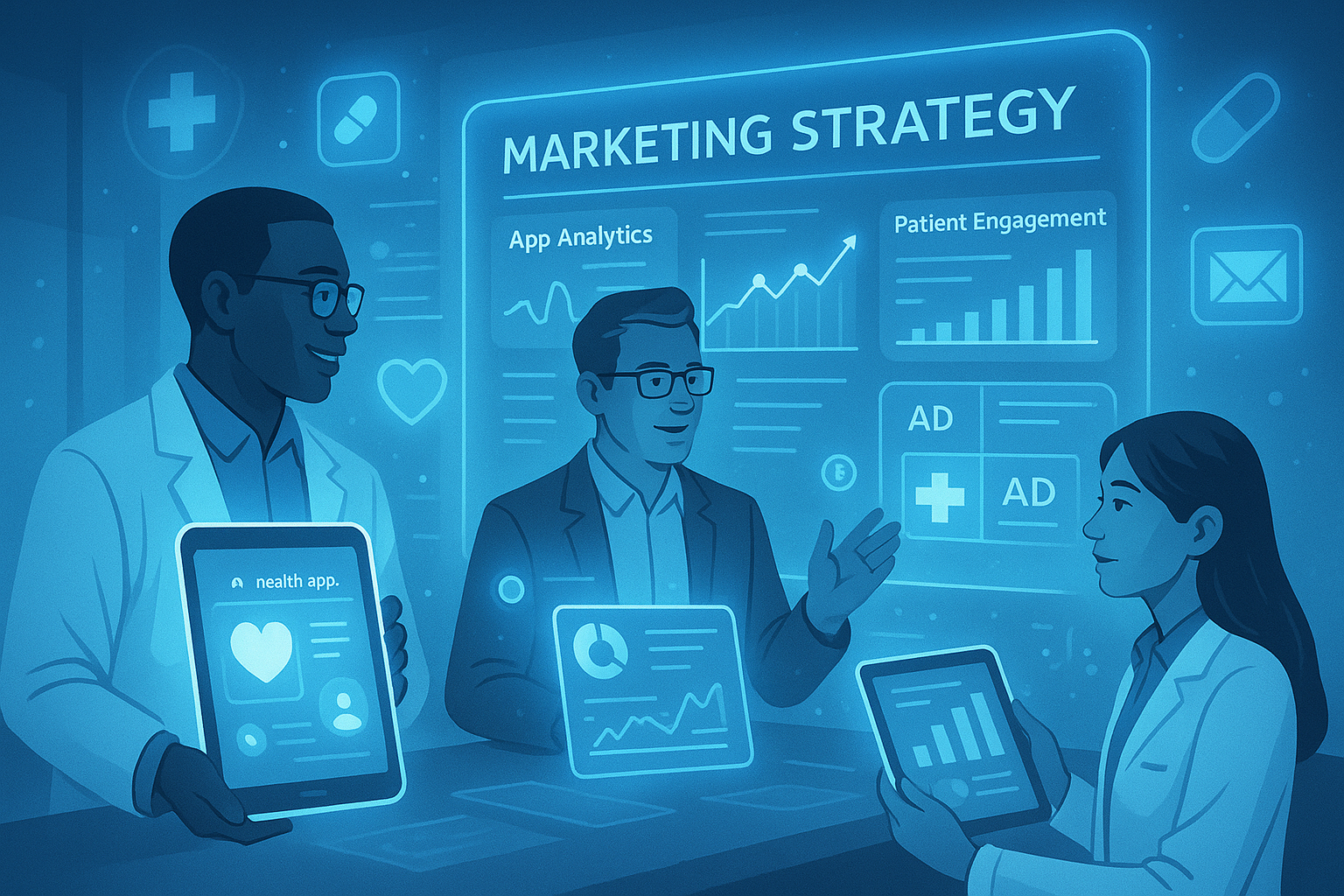Your digital health solution is innovative. It’s backed by solid technology, validated by clinical evidence, and designed to genuinely improve patient outcomes. You’ve invested years of development, substantial capital, and countless hours refining your product until it truly delivers value. There’s just one problem: so have hundreds of other companies.
The digital health marketplace in 2025 is extraordinarily crowded. The mobile medical apps market is projected to reach USD $50.94 billion by 2030, attracting massive investment and fierce competition. 76% of consumers are actively seeking digital solutions to support their wellness journeys, creating unprecedented opportunity—but also unprecedented noise.
Standing out in this crowded marketplace requires more than a great product. It demands strategic differentiation, targeted messaging, multi-channel execution, and deep understanding of the complex healthcare buying landscape. There’s no single marketplace or buyer for digital health solutions, but rather an assortment of potential customers with wildly different business drivers, buying preferences and evidence requirements.
This comprehensive guide provides proven strategies for marketing digital health solutions effectively, cutting through the noise to reach decision-makers, build credibility, and drive adoption in one of the most competitive industries in the world.
Understanding the Crowded Digital Health Landscape
Before developing marketing strategies, you must understand what you’re competing against and why differentiation has become so challenging.
The Explosion of Digital Health Solutions
The digital health sector has experienced explosive growth driven by multiple convergent trends. COVID-19 accelerated digital adoption by years, perhaps decades. In 2025, 44% of surveyed consumers said they had had a telehealth visit in the past year, and 94% of those people said they were willing to have another one. This normalization of digital healthcare created opportunity—and attracted intense competition.
Investment has poured into the space, funding thousands of startups pursuing similar opportunities. Remote patient monitoring, mental health apps, chronic disease management platforms, telemedicine solutions, wellness tracking—nearly every healthcare challenge now has dozens of digital solutions claiming to solve it.
The HealthTech market nearly doubled in size in 2020 due to a surge of HealthTech IPOs, and growth has continued since. More competitors enter daily, and increased investment in digital marketing across the board means the bar for visibility continues rising.
Multiple Stakeholders, Complex Decision-Making
Unlike consumer products with straightforward purchase paths, digital health solutions face complex, multi-stakeholder decision processes. Depending on the commercial model, the answer may be public or private health plans, healthcare providers, employers or patients—or, possibly, all of the above.
Each stakeholder has different priorities:
Payers (insurance companies, employers) care about reducing costs, improving outcomes, and member satisfaction. They need evidence of ROI and integration with existing systems.
Providers (hospitals, clinics, physicians) want solutions that integrate seamlessly into workflows, don’t add administrative burden, improve patient care, and ideally generate revenue or reduce costs.
Patients seek convenience, accessibility, effectiveness, and affordability. They want solutions that actually work without requiring significant behavior change.
Regulators require evidence of safety, efficacy, data security, and compliance with healthcare regulations.
Marketing effectively means crafting different value propositions, messages, and approaches for each stakeholder—all while maintaining brand consistency.
The Evidence Trap
You need customers to generate evidence, but you need evidence to get customers. Breaking this cycle requires creative approaches to evidence generation, strategic pilot partnerships, and sophisticated storytelling that builds credibility before comprehensive data exists.
Foundation: Defining Your Unique Value Proposition
In crowded markets, clear differentiation isn’t optional—it’s survival. In healthcare, the cornerstone of success is differentiation. Communicate exactly how your services are superior to any other option.
The Problem-Solution Framework
Start by clearly defining THE PROBLEM you solve. Not the technical problem, but the real-world problem that stakeholders experience daily. The most successful wellness applications clearly articulate how they differentiate from competitors by addressing specific pain points.
Then identify your “next best existing alternative”—what do people do today without your solution? Your competition isn’t just other digital health apps; it’s:
- Doing nothing
- Manual workarounds
- Existing non-digital solutions
- Different approaches to the same problem
- Adjacent solutions that partially address the issue
Understanding your true competition reveals your actual value proposition. RunKeeper can define their next best existing alternative as running without any tracking app at all. This perspective fundamentally changes how you position, market, and message your solution.
Differentiation Beyond Features
Differentiation opportunities include:
Clinical Approach: Is your methodology fundamentally different? Does your solution incorporate unique therapeutic approaches?
User Experience: Many digital health solutions work but are cumbersome. If yours is genuinely easier to use, that’s powerful differentiation.
Integration Capabilities: Seamless integration with existing EMRs, health systems, or workflows provides massive value.
Target Population: Perhaps you don’t serve everyone—you serve a specific population exceptionally well.
Evidence Base: Superior clinical evidence or real-world outcomes data separates leaders from followers.
Business Model: Unique pricing, reimbursement pathways, or partnership structures can differentiate.
Support and Services: Technical solutions are commoditizing; human support and services provide lasting differentiation.
Positioning for Different Stakeholders
Your core value proposition remains consistent, but messaging must adapt to each stakeholder’s priorities.
For Payers: “Our solution reduces hospital readmissions by 23%, saving $1,850 per patient annually while improving member satisfaction scores.”
For Providers: “Seamlessly integrated into your existing EMR, our platform requires zero additional documentation time while enabling proactive intervention that improves outcomes.”
For Patients: “Manage your condition from home with personalized guidance, connecting you with your care team when you need them—without extra appointments or travel.”
Same solution, different emphasis reflecting what each stakeholder cares about most.
Multi-Channel Marketing Strategy for Digital Health
Content Marketing: The Foundation
When you are going after national search rankings, educational material is your friend and ally to drive major search traffic volume to your website. Take a look at disruptors from recent years and you will find that they have adopted an incredibly effective blog education content strategy.
Why Content Works for Digital Health:
Content marketing addresses the evidence trap by demonstrating expertise before prospects become customers. High-quality educational content builds trust, establishes thought leadership, and improves search visibility—all while providing genuine value.
A nutrition tracking app might publish content on macronutrient balancing, interview registered dietitians who recommend the app’s approach, showcase user transformation stories, reference clinical studies on dietary tracking, and provide guides for meal planning. This multi-dimensional content approach addresses different stages of the user journey.
Content Types That Work:
Educational Blog Posts: Address the questions your target audience is actively searching for. Check out Roman the men’s health company. Almost all of the major traffic generators to the website are information-based articles and blogs.
Clinical White Papers: Demonstrate scientific rigor with detailed explorations of methodology, evidence, and outcomes.
Case Studies: Real-world examples of implementation, challenges overcome, and results achieved build credibility more effectively than promotional materials.
Video Content: Creating long-form tutorial videos that address common issues, or reaching potential patients on informal platforms increases engagement. Wellness apps providing robust educational content experience 67% higher user engagement than those focusing solely on app features.
Webinars and Virtual Events: Live educational sessions position your team as experts while generating qualified leads.
Original Research: Publishing original studies or analyses establishes unmatched credibility.
Search Engine Optimization: Be Found When It Matters
Technical SEO Foundations:
Ensure your website is technically sound:
- Fast loading speeds (under 3 seconds)
- Mobile-optimized responsive design
- Secure HTTPS implementation
- Clean URL structures
- Proper schema markup for healthcare content
- XML sitemap and robots.txt optimization
Keyword Strategy for Digital Health:
Target keywords across the awareness-to-decision spectrum:
Awareness Stage: “symptoms of [condition],” “how to manage [disease],” “digital health solutions for [problem]”
Consideration Stage: “best apps for [condition],” “[solution type] comparison,” “how does [technology] work”
Decision Stage: “[your solution] vs [competitor],” “[solution] pricing,” “[solution] reviews”
Local SEO for Provider-Focused Solutions: If targeting specific healthcare systems or geographic areas, optimize for local search with location pages, Google Business Profiles, and local citations.
Paid Advertising: Accelerate Visibility
Google Ads Strategy:
Search Campaigns: Target high-intent keywords where prospects are actively seeking solutions. Performance Max Campaigns have been around for a while but still new compared to the traditional set up, leveraging AI-based optimization.
Display Advertising: Build awareness among defined audiences through visual ads across relevant websites.
YouTube Advertising: Video ads can effectively demonstrate solutions while targeting healthcare professionals or patients.
Remarketing: Follow website visitors across the web, keeping your solution top-of-mind as they evaluate options.
Budget Considerations: A paid search competitive analysis provides estimated monthly spending/budgets, giving you valuable insight into how aggressively your competitors are leveraging the paid search marketplace.
Social Media Advertising:
LinkedIn: Essential for B2B digital health solutions targeting healthcare administrators, payers, or system decision-makers. Use sponsored content, message ads, and lead generation forms.
Facebook/Instagram: Effective for DTC solutions and building awareness among patient populations. Leverage detailed targeting and lookalike audiences.
Twitter/X: Useful for thought leadership and engaging with healthcare influencers and journalists.
Strategic Partnerships and Collaborations
Partnership Opportunities:
Healthcare Provider Partnerships: Pilot programs with health systems, clinics, or physician groups generate evidence while creating reference customers.
Payer Collaborations: Partnering with insurance companies for coverage or reimbursement provides massive credibility and market access.
Technology Integrations: Integration with EMR systems, wearable devices, or other healthcare platforms creates network effects and differentiation.
Academic Institutions: Research partnerships with universities or medical schools enhance credibility and generate publishable evidence.
Patient Advocacy Organizations: Partnerships with condition-specific advocacy groups provide access to target populations and third-party validation.
Corporate Wellness Programs: Employer partnerships for wellness solutions create predictable revenue and usage at scale.
Email Marketing: Direct, High-ROI Engagement
Email marketing still delivers exceptional ROI. Automated, HIPAA-compliant campaigns save time and personalize follow-ups based on patient segments. The average open rate for emails related to medical, dental, and healthcare is 44.60%.
Email Strategy Components:
Segmentation: HIPAA-compliant segmentation tailors outreach to different patient groups without disclosing protected health details. Segment by stakeholder type, use case, engagement level, and position in buying journey.
Nurture Sequences: Educational drip campaigns that gradually build knowledge, trust, and purchase intent over weeks or months.
Product Updates: Keep users and prospects informed about new features, integrations, or capabilities.
Success Stories: Regular sharing of case studies, testimonials, and outcome data reinforces value.
Event Invitations: Webinars, conferences, demos, or virtual events delivered via email to segmented lists.
Trigger-Based Campaigns: Automated emails based on specific behaviors—website visits, content downloads, demo requests, or usage patterns.
Building Credibility and Trust
In healthcare, trust isn’t nice-to-have—it’s prerequisite. Public trust in healthcare is extremely fragile. It takes years to build but can be lost in moments.
Clinical Evidence and Validation
Customers will want to see evidence of either clinical or economic value before buying. Types of evidence that build credibility:
Clinical Trials: Randomized controlled trials provide gold-standard evidence but require significant investment.
Real-World Evidence: Observational studies, registry data, and pragmatic trials demonstrating effectiveness in actual clinical practice.
Economic Analyses: Cost-effectiveness studies, ROI analyses, and budget impact models matter enormously to payers and healthcare systems.
User Outcomes: Patient-reported outcomes, quality-of-life measures, and satisfaction data complement clinical metrics.
Peer-Reviewed Publications: Publishing in respected medical journals signals scientific rigor and earns physician trust.
Regulatory Credentials
Regulatory clearance or approval provides substantial credibility:
FDA Clearance/Approval: Demonstrates safety and efficacy validation by trusted regulator.
CE Mark: European regulatory approval opens international markets while signaling quality.
HIPAA Compliance: Essential for any solution handling protected health information.
SOC 2 Certification: Security certification increasingly expected by healthcare enterprises.
Disease-Specific Certifications: Diabetes education recognition, cardiac rehabilitation accreditation, or similar condition-specific credentials.
Thought Leadership
Positioning yourself as a thought leader in the healthcare industry differentiates you from competitors selling similar functionality.
Thought Leadership Tactics:
Conference Speaking: Present at major healthcare conferences (HIMSS, ATA, disease-specific conferences).
Media Contributions: Contribute expert commentary to healthcare publications, respond to journalist queries via HARO.
Industry Leadership: Serve on advisory boards, standards committees, or industry associations.
Original Research: Conduct and publish surveys, analyses, or studies that advance industry knowledge.
Executive Visibility: Position C-suite executives as experts through interviews, podcasts, and bylined articles.
Social Proof: Reviews, Testimonials, and Case Studies
86% of patients will check reviews before making a decision, and the same applies to B2B healthcare buyers.
Building Social Proof:
Customer Testimonials: Video testimonials from physicians, administrators, or patients (with proper authorization) provide authentic endorsement.
Case Studies: Detailed stories of implementation, challenges, and outcomes demonstrate real-world value.
User Reviews: Encourage satisfied customers to review your solution on platforms like G2, Capterra, or healthcare-specific sites.
Reference Customers: Willing to speak with prospects, reference customers accelerate enterprise sales.
Awards and Recognition: Industry awards, “best of” lists, or analyst recognition (Gartner, KLAS) enhance credibility.
Optimizing for AI and Emerging Search
AI Search Optimization
As AI-powered search (Google’s AI Overviews, ChatGPT, Perplexity) becomes dominant, optimization strategies must evolve:
Create Authoritative Content: Invest in creating differentiated, authoritative content that serves both AI and human audiences while maintaining high medical accuracy and usefulness.
Structure for AI Consumption:
- Clear headings and logical hierarchy
- Concise, definitive answers to common questions
- Factual, well-cited information
- Structured data markup
- FAQ sections addressing key queries
Combat with Depth: Combat AI summaries by offering in-depth, detailed health content that entices users eager for comprehensive insights. Position yourself as a trusted authority while boosting conversions.
Address Follow-Up Questions: AI often surfaces related questions. Anticipate and answer these to maximize visibility in AI-generated results.
Voice Search Optimization
One commonality among modern healthcare consumers is a desire for online options, including voice-activated search and assistance.
Optimize for voice search by:
- Using natural, conversational language
- Answering specific questions directly
- Creating FAQ content
- Optimizing for long-tail, question-based keywords
- Ensuring fast mobile page speeds
- Claiming and optimizing local business listings
Measurement and Optimization
Key Performance Indicators
Awareness Metrics:
- Website traffic (overall and by source)
- Search rankings for target keywords
- Brand search volume
- Social media reach and engagement
- Media mentions and share of voice
Consideration Metrics:
- Content engagement (time on page, scroll depth, video completion)
- Email open and click-through rates
- Webinar registrations and attendance
- White paper and content downloads
- Demo requests
Conversion Metrics:
- Trial sign-ups or freemium conversions
- Sales qualified leads (SQLs)
- Deal velocity and close rates
- Customer acquisition cost (CAC)
- Customer lifetime value (LTV)
Retention and Advocacy:
- User activation and engagement
- Feature adoption rates
- Net Promoter Score (NPS)
- Churn rate
- Customer testimonials and referrals
Data-Driven Optimization
Optimization Framework:
- Monitor Shifts Regularly: Track new regulations, tech trends, and local market changes.
- Check Analytics Frequently: Identify underperforming channels or content, seasonal patterns, and emerging opportunities.
- A/B Test Systematically: Test headlines, calls-to-action, landing page designs, email subject lines, and ad creative.
- Spot Emerging Audiences: Use data to uncover overlooked segments and adjust campaigns accordingly.
- Stay Agile: Pivot quickly based on real-time insights to avoid missed opportunities.
- Balance Analytics with Empathy: Combine data with inclusive messaging to boost long-term patient acquisition and retention.
Overcoming Common Digital Health Marketing Challenges
Challenge 1: Long, Complex Sales Cycles
Problem: Healthcare buying decisions often take 6-18 months with multiple stakeholders.
Solutions:
- Develop content for every stage of the buyer journey
- Implement lead nurturing sequences that maintain engagement over time
- Create materials addressing concerns of each stakeholder type
- Use marketing automation to stay top-of-mind without manual effort
- Celebrate small wins (pilot programs, trials) rather than waiting for full sales
Challenge 2: Proving ROI Before Purchase
Problem: Buyers want evidence of value you can’t provide without customers.
Solutions:
- Offer free pilots or trials to generate initial evidence
- Create detailed ROI calculators showing projected value
- Leverage case studies from analogous situations
- Partner with academic institutions for validation studies
- Use testimonials from early adopters, even if data is preliminary
- Present third-party research supporting your approach
Challenge 3: Regulatory and Compliance Constraints
Problem: Healthcare regulations limit claims and marketing approaches.
Solutions:
- Work closely with regulatory affairs and legal counsel
- Focus on education rather than promotion
- Use careful language that stays within approved claims
- Leverage user testimonials (which have more latitude than company claims)
- Emphasize process and methodology rather than specific outcomes
- Build regulatory review into marketing workflows
Challenge 4: Differentiation in a Crowded Market
Problem: Multiple solutions claim similar benefits.
Solutions:
- Identify genuinely unique aspects (even if not product features)
- Focus on specific use cases or populations rather than trying to serve everyone
- Build partnerships that competitors can’t easily replicate
- Invest in proprietary research or evidence
- Create exceptional user experience as differentiator
- Develop unique content and thought leadership positioning
Challenge 5: Limited Marketing Resources
Problem: Startups and smaller companies can’t match enterprise marketing budgets.
Solutions:
- Focus resources on highest-impact channels (usually content and SEO)
- Leverage founder/executive networks for initial traction
- Pursue earned media rather than paid advertising
- Create remarkable products that generate organic word-of-mouth
- Use content repurposing to maximize asset value
- Prioritize conversion optimization over traffic acquisition
The Path Forward: Building Sustainable Growth
Marketing digital health solutions in crowded markets requires patience, persistence, and strategic thinking. There are no silver bullets, but there are proven approaches that consistently generate results.
Start with Differentiation: Be different from (and better than) the competition. If you can’t articulate what makes you genuinely different, why should anyone choose you?
Build Trust Through Evidence: Every piece of content, every partnership, every credential should reinforce that your solution delivers real value backed by real evidence.
Meet Buyers Where They Are: The modern patient journey spans a multitude of stops in the digital world. Be present across channels with consistent, valuable messaging.
Stay Agile: Digital health companies must be prepared to adapt and flex as they travel many potential go-to-market paths. What works today may not work tomorrow. Test, measure, and optimize continuously.
Focus on Customer Success: Your best marketing asset is customers who achieve remarkable outcomes and enthusiastically share their experiences. Prioritize customer success above all else.
The digital health marketplace will only become more crowded. But crowded doesn’t mean saturated—there’s still massive room for solutions that genuinely solve problems, demonstrate clear value, and market themselves strategically.
Your innovation deserves to reach the people who need it. With clear differentiation, multi-channel execution, evidence-based credibility, and relentless optimization, you can cut through the noise and build sustainable growth—even in the most crowded marketplace.
The opportunity is real. The competition is fierce. But for solutions that combine innovation with strategic marketing, the path to success, while challenging, is absolutely achievable.
Ready to cut through the noise and grow your digital health solution? Our team specializes in marketing strategies specifically for digital health companies, from positioning and messaging to multi-channel campaign execution and growth optimization. We understand the unique challenges of marketing in healthcare—evidence requirements, regulatory constraints, complex stakeholders—and we know how to navigate them successfully. Contact us today for a complimentary marketing assessment and discover how we can help your solution stand out in a crowded marketplace.
References
- Intrepy. (2025). “9 Biggest Healthcare Marketing Trends in 2025 with Examples.” Retrieved from https://intrepy.com/9-biggest-trends-in-healthcare-marketing-in-2023/
- Cardinal Digital Marketing. (2024). “Healthcare Marketing Trends in 2025: Marketers Doing More.” Retrieved from https://www.cardinaldigitalmarketing.com/healthcare-resources/blog/healthcare-marketing-trends-2025/
- Big Sea. (2025). “Top Healthcare Digital Marketing Trends in 2025.” Retrieved from https://bigsea.co/ideas/healthcare-digital-marketing/
- Healthcare Success. (2024). “11 Healthcare Marketing Predictions for 2025.” Retrieved from https://healthcaresuccess.com/blog/healthcare-marketing/11-healthcare-marketing-predictions-for-2025.html
- Big Drop. (2024). “The Future of Healthcare Marketing: 2025 Trends to Watch.” Retrieved from https://www.bigdropinc.com/blog/the-future-of-healthcare-marketing-2025-trends-to-watch/
- Waxcom. (2025). “Healthcare Digital Marketing in 2025: 6 Trends You Can’t Ignore.” Retrieved from https://waxcom.com/healthcare-digital-marketing-trends/
- Digital Silk. (2025). “15 Healthcare Marketing Strategies For 2025 ROI.” Retrieved from https://www.digitalsilk.com/digital-trends/healthcare-marketing-strategies/
- MedCity News. (2024). “Healthcare Marketing: Key Trends Shaping 2025.” Retrieved from https://medcitynews.com/2024/12/healthcare-marketing-key-trends-shaping-2025/
- SundaySky. (2025). “2025 Healthcare Marketing Strategy: Trends You Need to Know.” Retrieved from https://sundaysky.com/blog/2025-healthcare-marketing-trends/
- Healthline Media. “Health Marketing Trends Shaping 2025.” Retrieved from https://www.healthlinemedia.com/insights/2025-health-marketing-trends
- Healthcare Success. (2025). “Your Guide to Healthcare Industry Competitive Analysis for Branding & Digital Marketing.” Retrieved from https://healthcaresuccess.com/blog/healthcare-marketing/your-guide-to-healthcare-industry-competitive-analysis-for-branding-digital-marketing.html
- Healthcare Success. (2024). “Dominating the Competition with Healthcare Marketing.” Retrieved from https://healthcaresuccess.com/blog/healthcare-marketing/clobber-competition-healthcare-marketing.html
- LinkedIn. (2021). “Dear Digital Health Startup: You’re doing Competition Analysis Wrong.” Retrieved from https://www.linkedin.com/pulse/dear-digital-health-startup-youre-doing-competition-analysis-fisher
- Favoured. (2025). “Effective Marketing Strategies for Your Healthcare App: Unlock Success.” Retrieved from https://favoured.co.uk/effective-marketing-strategies-for-your-healthcare-app/
- ComboApp. (2023). “Healthcare Marketing Strategy: 14 Actionable Tips.” Retrieved from https://comboapp.com/healthcare-digital-marketing-agency/healthcare-marketing-strategy
- Callin. (2025). “Marketing Strategies for Wellness Apps in 2025.” Retrieved from https://callin.io/marketing-strategies-for-wellness-apps/
- ZS. (2025). “Commercializing Digital Health Solutions and Strategies.” Retrieved from https://www.zs.com/insights/commercializing-digital-solutions-the-struggle-is-real
- GoRatio. (2023). “Mastering Your Healthcare Competitive Analysis: A Comprehensive Seven-Step Framework.” Retrieved from https://goratio.com/blog/7-steps-guide-healthcare-competitive-analysis
- Exposure Ninja. (2025). “Digital Marketing Strategy for Healthcare: 2026 Guide.” Retrieved from https://exposureninja.com/blog/digital-marketing-strategy-for-healthcare/
- IJFMR. (2025). “Ethical Marketing and Brand Management of Prescription Pharmaceuticals.” Retrieved from https://www.ijfmr.com/papers/2025/4/49375.pdf




